Pride & Prejudice - Movie Review
 Pride & Prejudice 2005
Pride & Prejudice 2005First, a history lesson. Relax, you mooks, it won’t take long. When we first heard there was to be a new film version of Jane Austen’s “Pride & Prejudice” we too jumped the gun and thought, oh dearest us, not another one! Well, we must take that back, ‘cause in our research – you do realize we do research, we’re not just flying by the seat of our Diesels® kinda hack entertainment journalists ya know, anywho in our research we discovered that this latest incarnation would be the first cinematic straight adaptation of “P&P” since MGM’s glittering 1940 version. What!! But what about the lovely 1995 BBC version starring Jennifer Ehle and Colin Firth and countless others? Well, if you actually paid attention, there have been umpteen versions made strictly for television, as either a movie or mini-series. And we’re talking about the big screen, you dolts. And we’re not counting any modernized adaptations or the Wog version. As much as we love our mini-series, it would be completely ignorant and foolish of us to compare one to a big screen adaptation. The medium is entirely different. What one can do with two, three, four or seventeen episodes is radically different than choosing to adapt a piece of literature to the major motion picture screen. So there. Nyah!
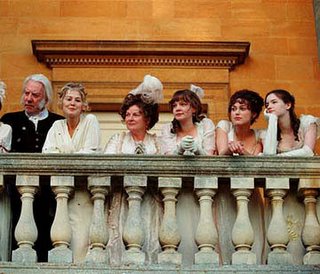 Now, back to the latest version. As many Jane Austen nutjobs . . . er, fans will tell you, “Pride & Prejudice” tells the tale of a down on their shillings family, the Bennets whose father and in particular, mother are simply mad to marry off their gaggle of five daughters to decent, respectable, and hopefully filthy rich bachelors. Very pro-woman, this piece. The eldest daughter, Elizabeth is the “headstrong” (Read: uptight twat) one who fancies nothing more than enjoying the simple rustic charms of semi-poverty and an occasional good potboiler. Her sister Jane is the “pretty one” (Read: horny slut), who would like nothing better than to marry the rich, eligible new neighbor. The next two bitches are Lydia and Kitty who are basically the Paris and Nicole of their day. And then there’s the ugly lesbian daughter, Mary.
Now, back to the latest version. As many Jane Austen nutjobs . . . er, fans will tell you, “Pride & Prejudice” tells the tale of a down on their shillings family, the Bennets whose father and in particular, mother are simply mad to marry off their gaggle of five daughters to decent, respectable, and hopefully filthy rich bachelors. Very pro-woman, this piece. The eldest daughter, Elizabeth is the “headstrong” (Read: uptight twat) one who fancies nothing more than enjoying the simple rustic charms of semi-poverty and an occasional good potboiler. Her sister Jane is the “pretty one” (Read: horny slut), who would like nothing better than to marry the rich, eligible new neighbor. The next two bitches are Lydia and Kitty who are basically the Paris and Nicole of their day. And then there’s the ugly lesbian daughter, Mary. Into their drab little dilapidated country estate . . . how quaint, arrive two eligible rich bachelors (Imagine! What luck!), the eager to please Mr. Bingley, and the brooding and aloof Mr. Darcy. With some Cruella de Ville type in tow . . . (We blocked her out, she was played so “Saturday Afternoon Serial Villainess”ish.) Jane (the horny slut) falls in love with Mr. Bingley, Elizabeth (the uptight twat) is offended by Mr. Darcy, their mother is foaming at the mouth at the thought of one of her daughters finally getting hitched and the romp begins.
Into their drab little dilapidated country estate . . . how quaint, arrive two eligible rich bachelors (Imagine! What luck!), the eager to please Mr. Bingley, and the brooding and aloof Mr. Darcy. With some Cruella de Ville type in tow . . . (We blocked her out, she was played so “Saturday Afternoon Serial Villainess”ish.) Jane (the horny slut) falls in love with Mr. Bingley, Elizabeth (the uptight twat) is offended by Mr. Darcy, their mother is foaming at the mouth at the thought of one of her daughters finally getting hitched and the romp begins. Now, we wouldn’t dream of spoiling the plot twists and turns and surprise ending. (Mr. Darcy turns out to be wonderful, Elizabeth was wrong about him the entire time – he was too PROUD and she was too consumed with PREJUDICE, and they get married and live happily ever after.) Except to say if that if you have either read “Bridget Jones’s Diary” or hell, any piece of literature above the “Curious George” level, you pretty much know what is going to happen. And that really isn’t the point with Jane Austen anyway. The beauty of Jane Austen is in her ability to combine romantic comedy with social satire and great character studies. One should only hope that those three simple staples of La Austen’s work will shine thru in any big screen adaptation. They did. In 1940. Starring Greer Garson, Laurence Olivier, Maureen O’Sullivan, Heather Angel, Ann Rutherford, Mary Boland, Edmund Gwenn, and Edna May Oliver. It was directed by the prolific Robert Z. Leonard and co-adapted by the great novelist Aldous Huxley. And while it may not be on par with “Citizen Kane” or “8 ½” as one of the greatest films ever made, it is justifiably regarded as a delightful cinematic soufflé.
Now, we wouldn’t dream of spoiling the plot twists and turns and surprise ending. (Mr. Darcy turns out to be wonderful, Elizabeth was wrong about him the entire time – he was too PROUD and she was too consumed with PREJUDICE, and they get married and live happily ever after.) Except to say if that if you have either read “Bridget Jones’s Diary” or hell, any piece of literature above the “Curious George” level, you pretty much know what is going to happen. And that really isn’t the point with Jane Austen anyway. The beauty of Jane Austen is in her ability to combine romantic comedy with social satire and great character studies. One should only hope that those three simple staples of La Austen’s work will shine thru in any big screen adaptation. They did. In 1940. Starring Greer Garson, Laurence Olivier, Maureen O’Sullivan, Heather Angel, Ann Rutherford, Mary Boland, Edmund Gwenn, and Edna May Oliver. It was directed by the prolific Robert Z. Leonard and co-adapted by the great novelist Aldous Huxley. And while it may not be on par with “Citizen Kane” or “8 ½” as one of the greatest films ever made, it is justifiably regarded as a delightful cinematic soufflé.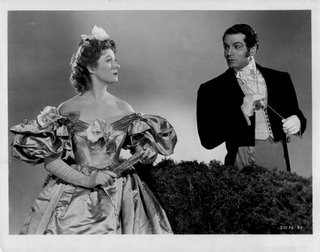 This latest version would be better compared to a cinematic scone that one dropped on the floor and dusted off and laid back on the dirty plate. There is nothing hideously wrong with this adaptation, if you don’t count half the casting, the screenplay and the horrendous cinematography. We have to pause and say that it has been years since the cinematography alone has ruined a movie for us, but the work done here by one Roman Osin is unworthy of being labeled “lazy” or “horrendous”. That would be too kind.
This latest version would be better compared to a cinematic scone that one dropped on the floor and dusted off and laid back on the dirty plate. There is nothing hideously wrong with this adaptation, if you don’t count half the casting, the screenplay and the horrendous cinematography. We have to pause and say that it has been years since the cinematography alone has ruined a movie for us, but the work done here by one Roman Osin is unworthy of being labeled “lazy” or “horrendous”. That would be too kind. On the plus side, the casting scores high marks for the brooding charms of Matthew MacFadyen as Mr. Darcy (God! What a voice!), the comic timing of Tom Hollander as Mr. Collins, and the polished and touchingly effective work done by three veterans: Donald Sutherland as Mr. Bennet, Judi Dench as Lady Catherine de Bourg, and the brilliant Brenda Blethyn as Mrs. Bennet. They almost saved the movie for us. Almost. If we could have seen them thru the muddy and hideously lit cinematography. The screenplay by one Deborah Moggach is pedestrian at best, and cloyingly attempts at some degree of modernity when it would have been better to emulate the Oscar winning screenplay by Emma Thompson for the fabulous Ang Lee adaptation of Jane Austen’s “Sense & Sensibility.” Rumor has it that the great Emma did a rewrite on this latest flick but refused any credit for it. She was right in not allowing her name to be besmirched. We can credit her for the good lines. Because we’re generous.
On the plus side, the casting scores high marks for the brooding charms of Matthew MacFadyen as Mr. Darcy (God! What a voice!), the comic timing of Tom Hollander as Mr. Collins, and the polished and touchingly effective work done by three veterans: Donald Sutherland as Mr. Bennet, Judi Dench as Lady Catherine de Bourg, and the brilliant Brenda Blethyn as Mrs. Bennet. They almost saved the movie for us. Almost. If we could have seen them thru the muddy and hideously lit cinematography. The screenplay by one Deborah Moggach is pedestrian at best, and cloyingly attempts at some degree of modernity when it would have been better to emulate the Oscar winning screenplay by Emma Thompson for the fabulous Ang Lee adaptation of Jane Austen’s “Sense & Sensibility.” Rumor has it that the great Emma did a rewrite on this latest flick but refused any credit for it. She was right in not allowing her name to be besmirched. We can credit her for the good lines. Because we’re generous.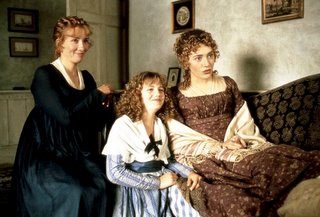 But the real problem lies in the casting of the kewpie doll Keira Knightley as Elizabeth Bennet. While Keira may have appeared in some successful films like “Bend It Like Beckham” “Pirates of the Caribbean: The Curse of the Black Pearl” and “Love Actually” she is not exactly known for her gifted handling of period dialogue. And boy howdy, does it show. While her tomboyish attitude may be slightly in synch with Elizabeth Bennet’s headstrong character traits, her inability to utter “Good Day, Mr. Darcy” without coming across as a twenty year old tart from Middlesex is not. We grant you that Miss Knightley is a lovely young bint, but one could hardly tell with THE FUCKING HIDEOUS CINEMATOGRAPHY!!!
But the real problem lies in the casting of the kewpie doll Keira Knightley as Elizabeth Bennet. While Keira may have appeared in some successful films like “Bend It Like Beckham” “Pirates of the Caribbean: The Curse of the Black Pearl” and “Love Actually” she is not exactly known for her gifted handling of period dialogue. And boy howdy, does it show. While her tomboyish attitude may be slightly in synch with Elizabeth Bennet’s headstrong character traits, her inability to utter “Good Day, Mr. Darcy” without coming across as a twenty year old tart from Middlesex is not. We grant you that Miss Knightley is a lovely young bint, but one could hardly tell with THE FUCKING HIDEOUS CINEMATOGRAPHY!!! Jesus H. Christ on a bed of arugula! What the fuck was director Joe Wright thinking of? And by the way, who the fuck is Joe Wright? Yo Wrong is more like it. What truly angered us with this piece is that we actually enjoyed several of the scene set-ups and we thought that the two ball sequences were staged with a graceful ingenuity we found quite refreshing. If we could only have SEEN THE FUCKING ACTORS!!!! This film should be taught in all film schools to demonstrate how bad cinematography can ruin interesting camerawork. Apparently, Roman Osin believes in lighting a scene in only one fashion. Harshly. Now we don’t expect every film, let alone every period film to be “Barry Lyndon”, we just would like to be able to think of Keira Knightley as something other that “Fat Face.” There, that got you, didn’t it? Obviously anybody who has ever seen Miss Knightley onscreen can tell you that she is anything but “Fat.” In fact, with her whippet thin frame and the clunky boots she sports under her empire waisted nightgown, she resembles one of the Olsen twins jotting out to the nearest Starbucks® for some Grade A Columbian finest, and a cup of coffee.
Jesus H. Christ on a bed of arugula! What the fuck was director Joe Wright thinking of? And by the way, who the fuck is Joe Wright? Yo Wrong is more like it. What truly angered us with this piece is that we actually enjoyed several of the scene set-ups and we thought that the two ball sequences were staged with a graceful ingenuity we found quite refreshing. If we could only have SEEN THE FUCKING ACTORS!!!! This film should be taught in all film schools to demonstrate how bad cinematography can ruin interesting camerawork. Apparently, Roman Osin believes in lighting a scene in only one fashion. Harshly. Now we don’t expect every film, let alone every period film to be “Barry Lyndon”, we just would like to be able to think of Keira Knightley as something other that “Fat Face.” There, that got you, didn’t it? Obviously anybody who has ever seen Miss Knightley onscreen can tell you that she is anything but “Fat.” In fact, with her whippet thin frame and the clunky boots she sports under her empire waisted nightgown, she resembles one of the Olsen twins jotting out to the nearest Starbucks® for some Grade A Columbian finest, and a cup of coffee.
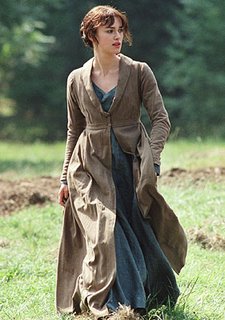 You don’t get thinner than that, kids. The close-ups of Keira were the deal breaker for us. If this wog can’t light a beautiful young lady like Keira, what hope do they have of establishing any kind of atmosphere or mood? None. That’s what.
You don’t get thinner than that, kids. The close-ups of Keira were the deal breaker for us. If this wog can’t light a beautiful young lady like Keira, what hope do they have of establishing any kind of atmosphere or mood? None. That’s what.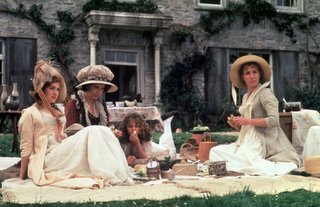 So, in closing – despite our yearning to be entertained by an intelligent romantic comedy, all we got for our money was eye-strain and a desire to go rent “Sense & Sensibility.” Now, THAT film has good lighting. Bless you all!
So, in closing – despite our yearning to be entertained by an intelligent romantic comedy, all we got for our money was eye-strain and a desire to go rent “Sense & Sensibility.” Now, THAT film has good lighting. Bless you all!(Closing History Lesson: We were recently in our salle de bain, pinching a loaf when we happened to read this quote from the November 18th edition of EW (Perfectly named - we might add) magazine. They were attempting to compare the 1940, 1995 BBC, and current versions. (What did we tell you about that! Read the opening paragraph again.) Anywho, this moron goes on to comment on our beloved 1940 MGM version, and we quote: “The costumes look off by several decades, as if they were swiped from the set of 1939’s “Gone With the Wind”. Now listen, you cross eyed git, the costumes for the lovely 1940 version were by the legendary Adrian who deliberately set the film at the height of the Romantic Era circa 1830s to take full advantage of the dashing male silhouette and the flouncy charm of the Gigot de Mouton sleeves. “Gone With the Wind” was brilliantly designed by Walter Plunkett, who set the opening scenes in the Crinoline Era of the 1860s thru the Bustle Period of the 1870s. Get your fucking facts right, you ignorant hack! Peace, love and light!)
Directed by Joe Wright
Written by Deborah Moggach
Based on the book by Jane Austen
Starring
Keira Knightley as Elizabeth Bennet
Matthew MacFadyen as Mr. Darcy
Judi Dench as Lady Catherine de Bourg
Rosamund Pike as Jane Bennet
Jena Malone as Lydia Bennet
Carey Mulligan as Kitty Bennet
Talulah Riley as Mary Bennet
Brenda Blethyn as Mrs. Bennet
Donald Sutherland as Mr. Bennet
Tom Hollander as Mr. Collins
Rupert Friend as Mr. Wickham
Cinematography by Roman Osin
Film Editing by Paul Tothill
Costume Design by Jacqueline Durran
Original Music by Darioi Marianelli
Production Design by Sarah Greenwood
Art Direction by Nick Gottschalk & Mark Swain
Set Decoration by Katie Spencer

 Now, we don’t want to give the impression we hated “Syriana”, since that is not the case. We enjoyed many things about it. Namely the casting of George Clooney and his fuck buddy, Matt Damon!! Whew!!
Now, we don’t want to give the impression we hated “Syriana”, since that is not the case. We enjoyed many things about it. Namely the casting of George Clooney and his fuck buddy, Matt Damon!! Whew!!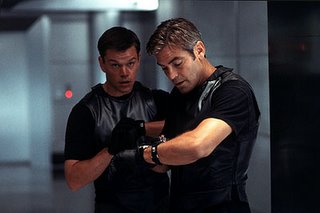 We would however be remiss in our duties if we failed to mention that this is the infamous acting role in which our pal George, fueled either by some latent
We would however be remiss in our duties if we failed to mention that this is the infamous acting role in which our pal George, fueled either by some latent  “Syriana” weaves a political tapestry of the under the table dealings between oil conglomerates and the Middle Eastern nations that are sitting upon the dinosaur bones that propel all those lovely
“Syriana” weaves a political tapestry of the under the table dealings between oil conglomerates and the Middle Eastern nations that are sitting upon the dinosaur bones that propel all those lovely  Now, you see what this film has done? It’s gone and got us all hot and bothered. We hate when that happens. Unless it involves George Clooney and Matt Damon. Then, we’re in. Sans weight gain. Although, our pal George is quite good in this performance. Other notable turns include the underappreciated
Now, you see what this film has done? It’s gone and got us all hot and bothered. We hate when that happens. Unless it involves George Clooney and Matt Damon. Then, we’re in. Sans weight gain. Although, our pal George is quite good in this performance. Other notable turns include the underappreciated  Back to the flick in question. We will be the first to say that films can be the perfect medium for multi-character, interwoven storytelling: from “
Back to the flick in question. We will be the first to say that films can be the perfect medium for multi-character, interwoven storytelling: from “ Two, Gaghan is simply not up to the task of directing. Sorry. There it is. We thank you for your hard work, and your best intentions, but please put down
Two, Gaghan is simply not up to the task of directing. Sorry. There it is. We thank you for your hard work, and your best intentions, but please put down 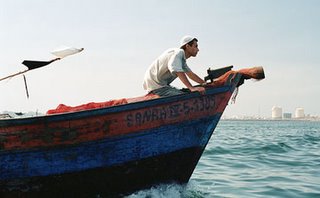 Closing note: So about that title? Here is what Stephen Gaghan had to say - "While 'Syriana' is a very real term used by
Closing note: So about that title? Here is what Stephen Gaghan had to say - "While 'Syriana' is a very real term used by 
 There’s good news and bad news about the latest big budget biopic to hit the multi-screens. We’ll start with the good: Johnny Cash and June Carter Cash as the subject matter and Joaquin Phoenix and Reese Witherspoon as their interpreters. Plaudits and kudos all around! We have been long time fans of the
There’s good news and bad news about the latest big budget biopic to hit the multi-screens. We’ll start with the good: Johnny Cash and June Carter Cash as the subject matter and Joaquin Phoenix and Reese Witherspoon as their interpreters. Plaudits and kudos all around! We have been long time fans of the 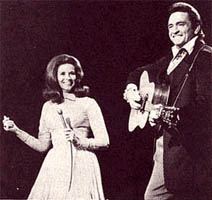 Charting the true story of any legend can be haphazard at best, or overblown, or just plain maudlin . . . and with the dual chore of attempting to parlay the great love story of musical legends Johnny Cash and June Carter Cash, the filmmakers bite off a bit more than they can chew. Ever since the movies began, we have been sitting back in our seats and viewing biopics of the great men and women in history. From the biography craze in the 1930’s that brought us “
Charting the true story of any legend can be haphazard at best, or overblown, or just plain maudlin . . . and with the dual chore of attempting to parlay the great love story of musical legends Johnny Cash and June Carter Cash, the filmmakers bite off a bit more than they can chew. Ever since the movies began, we have been sitting back in our seats and viewing biopics of the great men and women in history. From the biography craze in the 1930’s that brought us “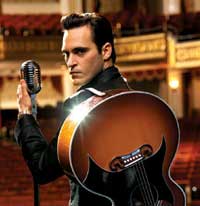 To many screengoers, Johnny Cash is the main draw with his famed “Man in Black” stage persona and litany of chart-toppers. And with his portrayal of the legend, Joaquin Phoenix banishes any doubt that he can deliver the goods as a leading man. He is simply amazing to watch. Obviously researching the hell out of the role, and practicing in front of his mirror at home, Joaquin lowers his vocal register and bravely attempts the singing chores along with the physical attributes that was the real Johnny Cash’s musical legacy. While anyone with a good ear could not be fooled into thinking that this is the real Johnny Cash singing, Joaquin manages to capture the style and delivery almost perfectly. To be able to sustain it for the many onstage musical scenes is nothing short of miraculous. All this would have meant nothing if Joaquin was not up to the dramatic and comedic moments in The Man in Black’s life. He is. Believe us, he is.
To many screengoers, Johnny Cash is the main draw with his famed “Man in Black” stage persona and litany of chart-toppers. And with his portrayal of the legend, Joaquin Phoenix banishes any doubt that he can deliver the goods as a leading man. He is simply amazing to watch. Obviously researching the hell out of the role, and practicing in front of his mirror at home, Joaquin lowers his vocal register and bravely attempts the singing chores along with the physical attributes that was the real Johnny Cash’s musical legacy. While anyone with a good ear could not be fooled into thinking that this is the real Johnny Cash singing, Joaquin manages to capture the style and delivery almost perfectly. To be able to sustain it for the many onstage musical scenes is nothing short of miraculous. All this would have meant nothing if Joaquin was not up to the dramatic and comedic moments in The Man in Black’s life. He is. Believe us, he is. June Carter, has unfortunately been slighted by some from her deserved co-position of legendary singer/songwriter, content as she was to bask in her husbands glory throughout the years. Tis a pity. ‘Cause the story of June Carter deserves its own Silver Screen tribute, but we will have to make due with the present. And in the personification of Reese Witherspoon, we are more than happy. Reese. Reese’s pieces. Reesala! We love you . . . again! We first became enamored of Reese with her film debut when she was a mere sprout of 14 in the coming of age drama “
June Carter, has unfortunately been slighted by some from her deserved co-position of legendary singer/songwriter, content as she was to bask in her husbands glory throughout the years. Tis a pity. ‘Cause the story of June Carter deserves its own Silver Screen tribute, but we will have to make due with the present. And in the personification of Reese Witherspoon, we are more than happy. Reese. Reese’s pieces. Reesala! We love you . . . again! We first became enamored of Reese with her film debut when she was a mere sprout of 14 in the coming of age drama “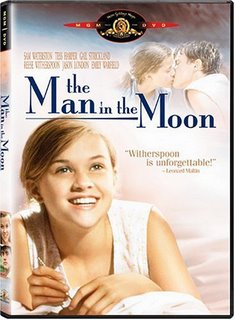 You’re done? Didn’t you just love it? We certainly did. Now, as with many youngsters, we weren’t quite sure that Reese was the real thing until we were delighted to sit back and watch her mature as an actress in a string of interesting roles. From her psychotic take on Little Red Riding Hood in “
You’re done? Didn’t you just love it? We certainly did. Now, as with many youngsters, we weren’t quite sure that Reese was the real thing until we were delighted to sit back and watch her mature as an actress in a string of interesting roles. From her psychotic take on Little Red Riding Hood in “ The best we can say about our lackluster response to James Mangold’s direction is that it’s pretty much what we expected from the man who helmed “
The best we can say about our lackluster response to James Mangold’s direction is that it’s pretty much what we expected from the man who helmed “ Directed by James Mangold
Directed by James Mangold
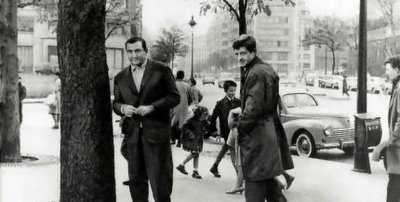 The only problem was that “
The only problem was that “ Without that particular cinematic blessing bestowed upon it, it lingered in limbo – never really obtaining an audience stateside. In Europe it was a different case. Building a Class “A” reputation over the decades to become respected wildly by many filmmakers. Finally, it earned enough respect to be completely restored, dusted off, set up with new subtitles and officially released this year! It is a gem. The film discovery of the year. We left the theatre on a cloud and still cannot believe that for over four decades it had languished in the celluloid dustbin.
Without that particular cinematic blessing bestowed upon it, it lingered in limbo – never really obtaining an audience stateside. In Europe it was a different case. Building a Class “A” reputation over the decades to become respected wildly by many filmmakers. Finally, it earned enough respect to be completely restored, dusted off, set up with new subtitles and officially released this year! It is a gem. The film discovery of the year. We left the theatre on a cloud and still cannot believe that for over four decades it had languished in the celluloid dustbin.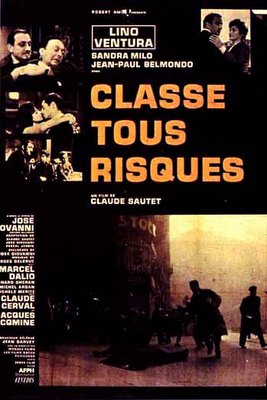
 Telling the tale of petty thief Abel Davos and his return to Paris after a self imposed exiled abroad, Sautet paints a portrait of the anti-hero as thug, father, teacher and saint.
Telling the tale of petty thief Abel Davos and his return to Paris after a self imposed exiled abroad, Sautet paints a portrait of the anti-hero as thug, father, teacher and saint. 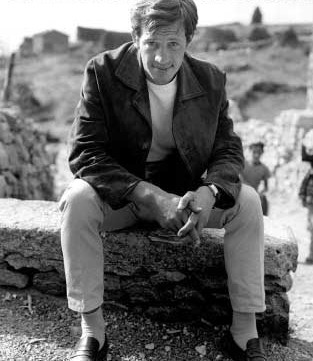 In his labyrinthine cat-and-mouse game with
In his labyrinthine cat-and-mouse game with 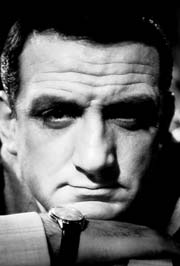 By saddling Abel with a wife and two sons, the severity of the situation is highlighted and humanized. While we are familiar with the anti-hero glorification of thieves and murderers in cinema lore, from “
By saddling Abel with a wife and two sons, the severity of the situation is highlighted and humanized. While we are familiar with the anti-hero glorification of thieves and murderers in cinema lore, from “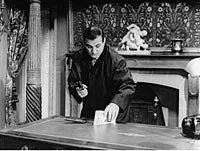 When we were absorbed watching this great film, we kept thinking to ourselves: “Selves, have we ever seen a crime neo-noir tell such a rich character study?” Not that we can recall. From the no-nonsense hardened career criminal that is Abel Davos to the young turk Eric Stark who aspires to help and continually risks his own life in the defense of his newfound pal, to the two young boys who play at the outskirts of the Asphalt Jungle – knowing full well that there time with their father may be limited. The seemingly casual scenes between Abel and a neighbor girl in his cold water hideaway play beautifully as a flirtation scene and pay off exquisitely when the slapdown comes and she subtly helps him pull off his escape.
When we were absorbed watching this great film, we kept thinking to ourselves: “Selves, have we ever seen a crime neo-noir tell such a rich character study?” Not that we can recall. From the no-nonsense hardened career criminal that is Abel Davos to the young turk Eric Stark who aspires to help and continually risks his own life in the defense of his newfound pal, to the two young boys who play at the outskirts of the Asphalt Jungle – knowing full well that there time with their father may be limited. The seemingly casual scenes between Abel and a neighbor girl in his cold water hideaway play beautifully as a flirtation scene and pay off exquisitely when the slapdown comes and she subtly helps him pull off his escape. The fence, who has history with Abel and his crew is played in a marvelously brittle fashion by that old Continental character actor Marcel Dalio of “
The fence, who has history with Abel and his crew is played in a marvelously brittle fashion by that old Continental character actor Marcel Dalio of “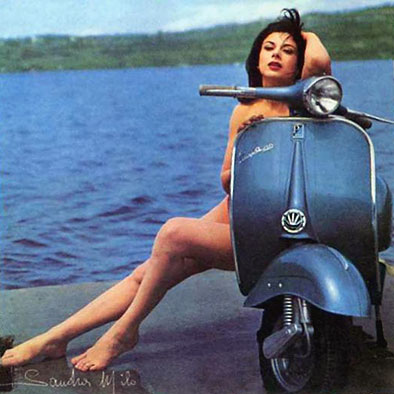 Abel’s former friends and colleagues in crime slowly begin to distance themselves in order to protect their own dens of inequity. But at what price? It is left to the protégée Erik Stark to fill in the missing role of reluctant right hand man, especially as his attention has of late been drawn to their roadside saviour, Liliane, as played by a young
Abel’s former friends and colleagues in crime slowly begin to distance themselves in order to protect their own dens of inequity. But at what price? It is left to the protégée Erik Stark to fill in the missing role of reluctant right hand man, especially as his attention has of late been drawn to their roadside saviour, Liliane, as played by a young 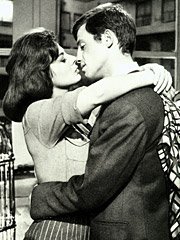 The manner in which Claude Sautet manages to bridge all the stories, tie them in thematically and use the various characters brilliantly for their own rewards is the very success of this film. Apparently it was a very slapdash, or shall we say
The manner in which Claude Sautet manages to bridge all the stories, tie them in thematically and use the various characters brilliantly for their own rewards is the very success of this film. Apparently it was a very slapdash, or shall we say 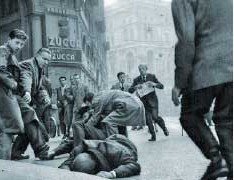 Which in many ways is all that you can ask for a film. One that draws you in from the very beginning, captures your heart and mind for a spell, and leaves you feeling weak from the totality of the experience. A great film. And a joy to have been brought back to us in such a classy restored edition. One for the ages. Bless you all!!
Which in many ways is all that you can ask for a film. One that draws you in from the very beginning, captures your heart and mind for a spell, and leaves you feeling weak from the totality of the experience. A great film. And a joy to have been brought back to us in such a classy restored edition. One for the ages. Bless you all!!
 That would come with HPIII – “Harry Potter & The Prisoner of Azkaban”, helmed by a true auteur, Señor Alfonso Cuarón, whose previous foray into the world of children’s literature brought forth the sublimely magical “
That would come with HPIII – “Harry Potter & The Prisoner of Azkaban”, helmed by a true auteur, Señor Alfonso Cuarón, whose previous foray into the world of children’s literature brought forth the sublimely magical “ Now, how did that happen? Anyway, back to the little wizards. Harry Potter is in his fourth year of his magical training at Hogwarts School of Witchcraft and Wizardry with his main bitches, Ron and Hermione close to his side. Looming in the distance is his mortal enemy, Lord Voldemort, the evil wizard who murdered Harry’s parents and has been tormenting the young mage ever since. Fortunately for Harry, when last we saw Voldemort he was literally half the man he used to be. In fact he bore an uncanny resemblance to the monster child in the 1970’s camp classic “
Now, how did that happen? Anyway, back to the little wizards. Harry Potter is in his fourth year of his magical training at Hogwarts School of Witchcraft and Wizardry with his main bitches, Ron and Hermione close to his side. Looming in the distance is his mortal enemy, Lord Voldemort, the evil wizard who murdered Harry’s parents and has been tormenting the young mage ever since. Fortunately for Harry, when last we saw Voldemort he was literally half the man he used to be. In fact he bore an uncanny resemblance to the monster child in the 1970’s camp classic “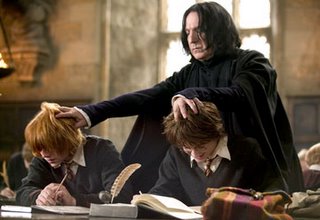 Now before we start detailing the plot, please keep in mind that this latest HP installment was derived from a book that outweighed War & Peace and Don Quixote combined. (Sidenote to author J.K. Rowling – your books should not outweigh their reader, luv.) It is a tribute to the screenwriter, Steve Kloves who has managed to whittle down the oversized tomes to a filmable length. Now while we have respected director Mike Newell’s work on “
Now before we start detailing the plot, please keep in mind that this latest HP installment was derived from a book that outweighed War & Peace and Don Quixote combined. (Sidenote to author J.K. Rowling – your books should not outweigh their reader, luv.) It is a tribute to the screenwriter, Steve Kloves who has managed to whittle down the oversized tomes to a filmable length. Now while we have respected director Mike Newell’s work on “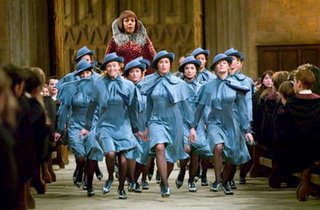 Hogwarts has been chosen as the host school for the Triwizard Tournament, a contest and gathering of the “three largest European schools of wizardry:
Hogwarts has been chosen as the host school for the Triwizard Tournament, a contest and gathering of the “three largest European schools of wizardry: 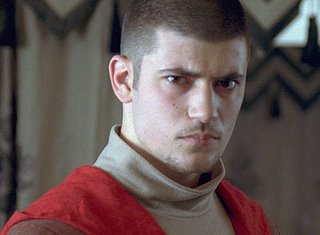
 . . . and the final hunt for the Goblet in a mist covered maze that stretches as far as the eye can see. Into this mystical Battle of the Network Wizards, is plopped a side story involving the Yule Ball which allows us to witness all of the uncomfortable
. . . and the final hunt for the Goblet in a mist covered maze that stretches as far as the eye can see. Into this mystical Battle of the Network Wizards, is plopped a side story involving the Yule Ball which allows us to witness all of the uncomfortable  As for the adults, most of the familiar faces have returned albeit in truncated scenes.
As for the adults, most of the familiar faces have returned albeit in truncated scenes. 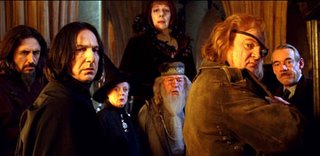 By now, this series is fairly impenetrable to critics’ arguments, but thankfully it need not fear any backlash if it continues to entertain and dazzle us with imagination, heart and cinematic storytelling. Kudos to the producers, directors and cast for keeping Harry Potter firmly astride his
By now, this series is fairly impenetrable to critics’ arguments, but thankfully it need not fear any backlash if it continues to entertain and dazzle us with imagination, heart and cinematic storytelling. Kudos to the producers, directors and cast for keeping Harry Potter firmly astride his  Directed by Mike Newell
Directed by Mike Newell
 “Jarhead” has many things going for it. Namely one. Jake Gyllenhaal. Our future husband, so relax ladies and boys, he’s off the market. Since his prepubescent toothy turn as Billy Crystal’s son in “
“Jarhead” has many things going for it. Namely one. Jake Gyllenhaal. Our future husband, so relax ladies and boys, he’s off the market. Since his prepubescent toothy turn as Billy Crystal’s son in “ Back to “Jarhead.” Based on the best selling memoir by former marine, Anthony Swofford, “Jarhead” tells the tale of a young idealistic marine who goes to war. But fails to find one. For those of you too young to remember, there was once an American president named
Back to “Jarhead.” Based on the best selling memoir by former marine, Anthony Swofford, “Jarhead” tells the tale of a young idealistic marine who goes to war. But fails to find one. For those of you too young to remember, there was once an American president named  Supporting cast members Jamie Foxx, Chris Cooper and Dennis Haysbert are all well cast as the local brass – but with the exception of Jamie Foxx are not allowed any moment to shine. Unfortunately Jamie Foxx’s moment to shine, while played convincingly falls short of the high water marks he is capable of. [See his wonderfully nuanced role in “
Supporting cast members Jamie Foxx, Chris Cooper and Dennis Haysbert are all well cast as the local brass – but with the exception of Jamie Foxx are not allowed any moment to shine. Unfortunately Jamie Foxx’s moment to shine, while played convincingly falls short of the high water marks he is capable of. [See his wonderfully nuanced role in “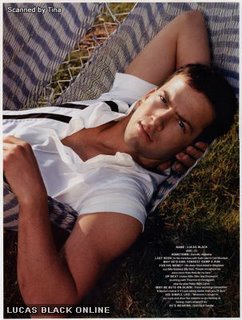 We must also pause to profess our undying love for young
We must also pause to profess our undying love for young 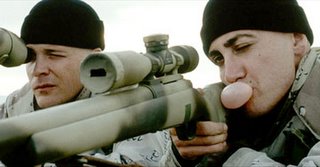 Whatever the physical cost of warfare, “Jarhead” focuses on the long and lazy moments in between gunfire barrages – and allows its characters to question their leaders and more importantly their own actions. This is where the film succeeds best. It takes the time to allow us to invest emotionally in the characters, so when the war finally arrives we are as nervous and edgy as they are. We must commend director Sam Mendes in casting our future husband Jake Gyllenhaal who rises to the occasion brilliantly. His breakdown scene with a fellow marine is excruciating to watch and never less than completely gripping. We know of a few other things we’d like to be gripping, but we’ll wait for “Brokeback Mountain” for that.
Whatever the physical cost of warfare, “Jarhead” focuses on the long and lazy moments in between gunfire barrages – and allows its characters to question their leaders and more importantly their own actions. This is where the film succeeds best. It takes the time to allow us to invest emotionally in the characters, so when the war finally arrives we are as nervous and edgy as they are. We must commend director Sam Mendes in casting our future husband Jake Gyllenhaal who rises to the occasion brilliantly. His breakdown scene with a fellow marine is excruciating to watch and never less than completely gripping. We know of a few other things we’d like to be gripping, but we’ll wait for “Brokeback Mountain” for that.
